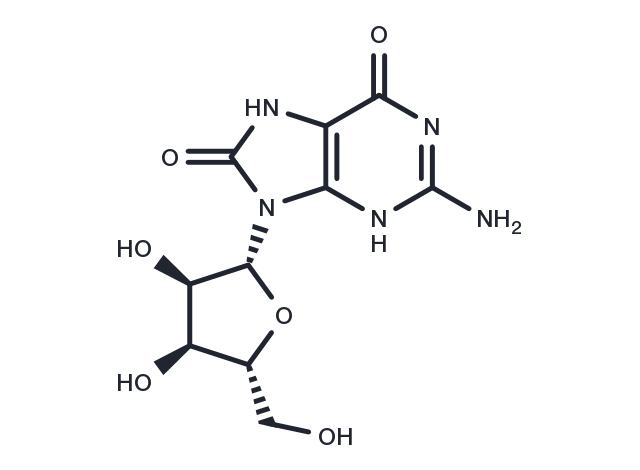Powder: -20°C for 3 years | In solvent: -80°C for 1 year


8-hydroxyguanosine (8-OHG) is a marker for measuring the rate of oxidative damage to nucleic acids and lipids.

| Pack Size | Availability | Price/USD | Quantity |
|---|---|---|---|
| 2 mg | In stock | $ 37.00 | |
| 5 mg | In stock | $ 61.00 | |
| 10 mg | In stock | $ 97.00 | |
| 25 mg | In stock | $ 194.00 | |
| 50 mg | In stock | $ 311.00 | |
| 1 mL * 10 mM (in DMSO) | In stock | $ 68.00 |



| Description | 8-hydroxyguanosine (8-OHG) is a marker for measuring the rate of oxidative damage to nucleic acids and lipids. |
| In vivo | The concentration of 8-OHG in CSF in Parkinson's disease (PD) patients is approximately three-fold that in controls. The concentration of 8-OHG in CSF decreased significantly with the duration of disease. However, the concentration of 8-OHG in serum was not significantly altered in PD patients compared to that in controls. |
| Molecular Weight | 299.24 |
| Formula | C10H13N5O6 |
| CAS No. | 3868-31-3 |
Powder: -20°C for 3 years | In solvent: -80°C for 1 year
DMSO: 240 mg/mL (802.03 mM)
You can also refer to dose conversion for different animals. More
bottom
Please see Inhibitor Handling Instructions for more frequently ask questions. Topics include: how to prepare stock solutions, how to store products, and cautions on cell-based assays & animal experiments, etc.
8-Hydroxyguanosine 3868-31-3 Metabolism Others Endogenous Metabolite 8 Hydroxyguanosine Inhibitor 8Hydroxyguanosine inhibit inhibitor
